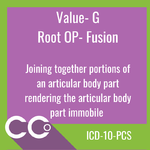
Fusion: Root Operation G
“Joining together portions of an articular body part rendering the articular body part immobile.” Fusion procedures are only performed on the joints, not the bones or vertebra. The only tables for fusion are found in the Upper Joints (0RG) and Lower Joints (0SG) body systems.
The body part value assigned is the specific joint being fused. When coding a spinal fusion at L1-L2, the body part value used is “0-Lumbar vertebral joint,” meaning one joint. If the fusion was performed at L1-L3, then the body part value that is assigned is “1-Lumbar vertebral joint, 2 or more,” meaning two joints.
Spinal fusions may use a variety of different devices such as autologous tissue substitute, interbody fusion device, internal fixation device, non-autologous tissue substitute, and external fixation device. Guideline B3.10c (see side bar on page 65) delineates how to apply the device value for fusion procedures when a combination of devices is used. An interbody fusion device is selected if the interbody fusion device is used with other material such as a bone graft—the bone graft would not be coded separately. When bone grafts are used as the only method for fusing a vertebral joint, either Autologous or Nonautologous tissue substitute is selected for the device value. If a mixture of autologous and nonautologous bone tissue is used at the same level, then the device value assigned is Autologous tissue substitute.
For vertebral joint fusion, qualifier values are used to specify the approach. These values delineate:1
- Anterior approach, anterior column—entry through the front of the body to perform a procedure on the body of the vertebra or disc
- Posterior approach, posterior column—entry through the back of the body to perform a procedure on the vertebral foramen, spinous process, facets and/or lamina
- Posterior approach, anterior column—entry through the back of the body to perform a procedure on the body of the vertebra or the disc
ICD-10-PCS Coding Guidelines: Fusion Procedures of the Spine
Coding Guideline B3.10a
The body part coded for a spinal vertebral joint(s) rendered immobile by a spinal fusion procedure is classified by the level of the spine (i.e., thoracic). There are distinct body part values for a single vertebral joint and for multiple vertebral joints at each spinal level.
Example: Body part values specify Lumbar Vertebral Joint, Lumbar Vertebral Joints, 2 or More, and Lumbosacral Vertebral Joint.
Coding Guideline B3.10b
If multiple vertebral joints are fused, a separate procedure is coded for each vertebral joint that uses a different device and/or qualifier.
Example: Fusion of lumbar vertebral joint, posterior approach, anterior column and fusion of lumbar vertebral joint, posterior approach, posterior column are coded separately.
Coding Guideline B3.10c
Combinations of devices and materials are often used on a vertebral joint to render the joint immobile. When combinations of devices are used on the same vertebral joint, the device value coded for the procedure is as follows:
- If an interbody fusion device is used to render the joint immobile (alone or containing other material like bone graft), the procedure is coded with the device value Interbody Fusion Device
- If bone graft is the only device used to render the joint immobile, the procedure is coded with the device value Nonautologous Tissue Substitute or Autologous Tissue Substitute
- If a mixture of autologous and nonautologous bone graft (with or without biological or synthetic extenders or binders) is used to render the joint immobile, code the procedure with the device value Autologous Tissue Substitute
Fusion of a vertebral joint using a bone dowel interbody fusion device made of cadaver bone and packed with a mixture of local morselized bone and demineralized bone matrix is coded to the device Interbody Fusion Device.
Fusion of a vertebral joint using both autologous bone graft and bone bank bone graft is coded to the device Autologous Tissue Substitute.


